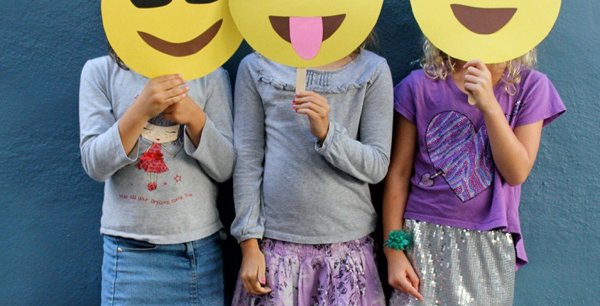5 Ways to Help Your Children Express Themselves

A picture says a thousand words, and maybe that’s why Emojis are such a popular part of our everyday conversations. Emojis are those colorful symbols that you see in texting and on social media sites. In our tech savvy age, they’ve revolutionized the way we express ourselves. July 17th is World Emoji day, and it’s the perfect opportunity to start supporting your children’s healthy self-expression.
Teaching your children about self-expression is important to their development—especially while they’re still young and haven’t experienced much peer pressure to “fit in” yet. Sacrificing personal expression in place of conformity is shown to lead to lower self-esteem, depression, and unhappiness in children.
By encouraging your kids to express themselves, you can ward off these negative issues and help your kids build self-confidence, independence, creativity, and self-advocacy. Fostering self-expression will set your children up for success.
How can I help my children express themselves?
Emphasize the arts
The arts are an easy way for your kids to express their feelings without saying a word. Art therapy is proven to improve physical, mental, and emotional well-being through creative self-expression for children (and adults, too!). It’s not just restricted to the traditional drawing or painting either—the arts can include music, dancing, and performance. Encourage your kids to try different art forms and explore their favorite artistic mediums.
Support style decisions
Fashion designer Marc Jacobs once said, “To me, clothing is a form of self-expression – there are hints about who you are in what you wear.” This is true for your kids as well! Let your children pick out their clothing, even if it looks silly, to encourage their self-expression. This will help them feel confident and unique wherever they go.
Offer opportunities to choose
Slowly introduce your children to the concept of choice. As toddlers, give them the option to pick a book for bed time or a special toy for playtime. When your children are a little older, give them more freedom by letting them decorate their room or choose their hairstyle, for example. By introducing the concept of choice, your children will learn what they do and do not like—which will help shape their understanding of themselves as they become adults.
Encourage exploration
It’s hard to give up control of your kids’ schedules, especially when you’re the one driving them around town. Yet it’s vitally important to let your children explore their own interests instead of the camps or activities you’ve picked out for them. Find websites and brochures for your kids in a variety of parent-approved activities and let them test out what they’re interested in—whether it be ballet or robotics, they’ll find their niche better if they decide.
Talk About Your Feelings
As a parent, you are your child’s biggest role model in life. Teach your children about healthy self-expression by discussing your emotions and why you are feeling sad, mad, or glad. Use our Emoji Feelings Chart to help them understand emotions physically! It will help them see how to properly express their feelings and make confusing emotions understandable.
Your children will grow to be confident, creative individuals as long as you give them the environment to do so. By helping your children practice self-expression, you are preparing them to be the best versions of themselves as they grow up.